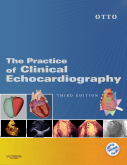-Description-
Dr. Otto's best-selling text not only explains how to qualitatively
and quantitatively interpret echocardiographic images and Doppler
flow data, but also outlines how this information affects your
clinical decision making. This edition features new chapters on
tissue doppler, intracardiac echocardiography, hand-held
echocardiography, and echocardiography in inherited connective tissue
disorders. A companion DVD offers case-based multiple-choice
questions to help you assess your understanding. Whether you are
attempting to choose a course of therapy, ascertain the optimal
timing for intervention, arrive at a prognosis, or determine the
possible need for periodic diagnostic evaluation, this is an
essential resource you'll consult time and time again.
-Key Features-
Delivers clear and concise coverage of the basics of image
acquisition that explains the how and why of echocardiography.
Reflects the latest technology and standards of practice.
Provides a clinically based approach to echocardiography, with an in-
depth discussion of the main cardiac events seen in practice,
including adult congenital heart disease.
Devotes extensive detail to training, education, and quality
assurance뾪aking it the most comprehensive text on echocardiography.
Includes a practical outline called The Echo Exam at the end of each
chapter that presents necessary calculations, diagnoses, and examples
along with guidance on how to interpret outcomes.
Includes a bonus DVD containing 3 cases and 5 multiple-choice
questions for each chapter that test your knowledge of the material.
Perfect resource for Residents preparing for the boards.
-New to this Edition-
Offers an expanded section on echocardiography techniques that
explains the latest applications for all types of practices.
Discusses new echocardiography modalities, including contrast and 3-D
echocardiography, so you can utilize the most promising new
approaches for your patients.
Includes new chapters on tissue doppler, intracardiac
echocardiography, hand-held echocardiography, and echocardiography in
inherited connective tissue disorders.
Uses new, full-color line drawings and new color Doppler images to
help you easily visualize cardiac problems.
-Table of Contents-
Chapter 1: Indications, Procedure, Image Planes and Doppler Flows
Transesophageal Echocardiography
Chapter 2: Monitoring Ventricular Function in the Operating Room
Chapter 3: Contrast Ultrasound Imaging
Chapter 4: Three Dimensional Echocardiography
Chapter 5: Tissue Doppler and Speckle Tracking Echocardiography
Chapter 6: Intracardiac Echocardiography
Chapter 7: Intravascular ultrasound: Principles and clinical
applications
Chapter 8: Hand-Carried Ultrasound
Chapter 9: Quantitative evaluation of left ventricular structure,
wall stress, and systolic function.
Chapter 10: Ventricular Shape and Function
Chapter 11: Assessment of Diastolic Function by Echocardiography
Chapter 12: Echocardiographic Digital Image Processing and Approaches
to Automated Border Detection
Chapter 13: The role of echocardiographic evaluation in patients
presenting with acute chest pain in the emergency room
Chapter 14: Echocardiography in the coronary care unit: Management of
Acute Myocardial
Infarction, Detection of Complications, and Prognostic Implications
Chapter 15: Exercise echocardiography
Chapter 16: Stress Echocardiography with Nonexercise Techniques
Chapter 17: Echocardiographic Evaluation of Coronary Blood Flow:
Approaches and Clinical Applications
Chapter 18: Quantitation of valvular regurgitation
Chapter 19: Timing of Intervention for Chronic Valve Regurgitation:
The Role of Echocardiography
Chapter 20: Intraoperative echocardiography in mitral valve repair.
Chapter 21: Echocardiography in the patient undergoing catheter
balloon mitral valvuloplasty: patient selection, hemodynami


